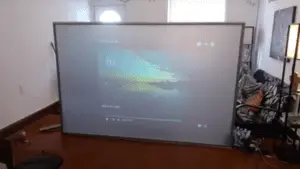Rear projection is like magic for your screen setup. Instead of having the projector in front, it beams the image from behind the screen. This way, you get a clear view without the projector’s light messing things up. It’s perfect for tight spaces or when you want a cleaner look. But heads up, not every projector can pull this off. You need the right gear to make it work.
Gear You Need for Rear Projection

Setting up rear projection isn’t rocket science, but you do need some specific stuff. Here’s the lowdown:
| Gear | What’s It For? |
|---|---|
| Projector | Needs to switch to rear projection mode. DLP projectors are top-notch for this. |
| Rear Projection Screen | Think glass, acrylics, fabric screens, or polymer fabric screens. |
| Mounting Hardware | Brackets or stands to keep the projector steady behind the screen. |
Most projectors can handle rear projection if they have the right settings. Many let you flip the image with just a button. DLP projectors are champs here because they give you sharp, colorful images. For the best bang for your buck, go for DLP tech combined with laser projection. This combo delivers killer brightness and color.
Types of Rear Projection Materials
When it comes to rear projection, picking the right material is key to getting the best picture. You’ve got options like glass, acrylics, fabric, and polymer screens, each with its own perks.
Glass and Acrylics
Glass and acrylics are popular choices for rear projection. They give you clear, sharp images that pop. Semi-rigid acrylics add a bit of flexibility without losing durability.
| Material Type | Benefits | Drawbacks |
|---|---|---|
| Glass | Super clear, scratch-resistant | Heavy, needs support |
| Rigid Acrylic | Light, shatter-resistant | Scratches easily |
| Semi-Rigid Acrylic | Flexible, durable | Not as clear as glass |
These materials help you get a top-notch rear projection setup with minimal distortion. Some screens work for both front and rear projection, but they might not be as good for front projection (Steantycip).
Fabric and Polymer Screens
Fabric and polymer screens are another go-to for rear projection. They’re lighter and easier to move around, making setup a breeze. Some are made just for rear projection, while others can handle both.
| Material Type | Benefits | Drawbacks |
|---|---|---|
| Fabric | Light, easy to move | Needs careful handling |
| Polymer | Tough, damage-resistant | Not as sharp as glass |
Fabric screens can look great, but make sure you get one designed for rear projection to keep the quality high. Check that your screen works well with your projector and gives you the brightness and clarity you need. If you need a bigger screen, check out how to enlarge projector screen.
In short, whether you go with glass, acrylics, fabric, or polymer screens, you’ve got solid options for rear projection. Pick what fits your needs, preferences, and budget best.
Things to Think About for Rear Projection
Deciding if rear projection fits your setup? Let’s break it down. Space, lighting, cost, and time all play a part in making the right call.
Space and Lighting
Rear projection needs some serious thought about your venue’s space and lighting. It can hog space, often needing a whole room for the projector. This might eat into your classroom or storage area, especially in older buildings with tight spaces.
But hey, there’s a silver lining. Rear projection can cut down on noise. By stashing the projector in another room, you can keep things quieter. Perfect for places like museums, theaters, and churches.
| What to Think About | What It Means |
|---|---|
| Space Needs | Needs its own room, might shrink usable space |
| Noise Levels | Can keep things quieter in noise-sensitive spots |
Cost and Time
Money matters. Rear projection setups can be pricey. The screens used for rear projection often cost more than front projection screens because of the fancy tech involved. This can hit your budget hard, so weigh the costs against what you really need.
Time’s another biggie. Setting up a rear projection system can take longer than front projection. It needs careful planning and installation. Getting a consultant or system integrator can help pick the right parts, saving you time and making your investment worth it.
| What to Think About | What It Means |
|---|---|
| Screen Cost | Usually higher for rear projection |
| Setup Time | Might need more time for planning and setup |
Knowing these points can help you figure out if rear projection is your best bet. Want more info on projector setups? Check out our links on can projector work on dark wall and how to enlarge projector screen.
Rear Projection vs. Front Projection
Choosing the right setup for your projector can be a game-changer. Let’s break down the differences between rear and front projection to help you make the best choice.
Image Quality Comparison
Image quality is a big deal when picking between rear and front projection. Rear projection shines in places with lots of light. It keeps the picture sharp and clear, even outdoors or in bright rooms (Wemax).
Front projectors bounce light off the screen. They can also look great, but they might struggle in bright settings unless you splurge on special screens or high-end projectors that handle ambient light well.
Here’s a quick look at how both types handle different conditions:
| Projection Type | Image Quality in Bright Light | Special Screen Needed |
|---|---|---|
| Rear Projection | Top-notch | Yes |
| Front Projection | Good to Great | Depends on setup |
Space and Installation Challenges
Setting up your projector can be a bit different depending on whether you go with rear or front projection. Rear projection needs a special screen, like glass or fabric, which can make things a bit trickier. You also need to think about where to put the projector behind the screen and make sure there’s enough room.
Front projection is usually more flexible. You can set it up in different spaces without needing special screens. But you do need to think about the distance from the projector to the screen, how high to mount it, and any obstacles in the way.
Here’s a comparison of the space and installation needs:
| Projection Type | Space Needed | Installation Difficulty |
|---|---|---|
| Rear Projection | Needs space behind the screen | More complex, needs special screens |
| Front Projection | Flexible space usage | Generally easier, can use common screens |
Both types have their perks and quirks. If you’re planning to use your projector in different settings, check out our article on can projector work on dark wall for more tips on getting the best setup.
Picking the Perfect Projector for Rear Projection
So, you’re diving into the world of rear projection and need the right projector to make your setup shine. Let’s break down the two main contenders: DLP projectors and LCD/LCoS projectors.
DLP Projectors
DLP (Digital Light Processing) projectors are the rockstars of the projector world. They’re the go-to for movie theaters and rear-projection TVs, and they also shine in professional settings. You’ve got two flavors here: single-chip DLP and three-chip DLP.
| Feature | Single-Chip DLP | Three-Chip DLP |
|---|---|---|
| Image Quality | Good | Excellent |
| Brightness | High | Higher |
| Cost | Lower | Higher |
| Color Accuracy | Moderate | Superior |
DLP projectors are known for their quick response times and vibrant colors, making them perfect for action-packed content. But, watch out for the “rainbow effect”—some folks might notice it in the images.
LCD and LCoS Projectors
LCD (Liquid Crystal Display) projectors are the lightweight champs. They’re easy to carry around and don’t have fast-moving parts, which means they’re often simpler and cheaper than DLP projectors. They deliver good color reproduction and are generally a breeze to maintain.
| Feature | LCD Projectors | LCoS Projectors |
|---|---|---|
| Image Quality | Good | Excellent |
| Color Accuracy | Good | Superior |
| Cost | Lower | Higher |
| Size | Portable | Generally larger |
LCoS (Liquid Crystal on Silicon) projectors are like the lovechild of LCD and DLP tech. They use liquid crystal chips with mirrored backings to pump out high-quality images with awesome color depth. But, they can be pricier than both LCD and DLP options.
When picking a projector for rear projection, think about your budget, where you’ll be using it, and what kind of content you’ll be showing. Each type has its perks and quirks, so choose the one that fits your needs best. Curious about other projector stuff? Check out our articles on can projectors have dead pixels or when to replace a projector lamp.
Troubleshooting Rear Projection Setup
Setting up a rear projection system can be a breeze, but a few hiccups might pop up. Here’s how to get the best out of your projector setup.
Screen Placement Tips
Getting the screen in the right spot is key for top-notch image quality. Here’s what to keep in mind:
- Distance from Projector: Make sure you’ve got the right gap between the projector and the screen. Short-throw projectors need about 4-6 feet, while ultra-short throw projectors only need 2-3 feet. This can save you some serious space.
- Alignment: Line up the projector with the center of the screen. If it’s off, you’ll get a wonky picture.
- Height: Set the screen at eye level. You might need to tweak the height of the projector or the screen.
Here’s a quick cheat sheet for projector distances:
| Projector Type | Distance Behind Screen |
|---|---|
| Short-Throw Projector | 4-6 feet |
| Ultra-Short Throw | 2-3 feet |
Dealing with Ambient Light
Rear projection works well in different lighting, but ambient light can still mess with your image. Here’s how to handle it:
- Use an ALR Screen: Ambient Light Rejection (ALR) screens cut down on surrounding light. They can make a big difference in bright rooms.
- Control Lighting: If you can, control the room’s lighting. Close curtains or blinds to block out light. For outdoor setups, pick a darker spot.
- Projector Brightness: Go for a projector with higher lumens for a brighter picture. DLP projectors with laser tech are great for this.
Follow these tips, and you’ll sort out any issues with your rear projection setup, giving you a clearer, more vibrant picture.

Paul Joseph is a seasoned writer and projector expert with a knack for troubleshooting and fixing projector issues. Through his informative articles, he shares valuable insights on projector maintenance, optimization, and reviews of top projector models. With a passion for technology, Paul remains dedicated to empowering readers in their projector journey.